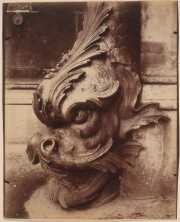Printing out paper
Description
One of two major classes of photographic papers; the other is develop out paper. First named in 1891 by the Ilford company, printing out paper (POP) is a general term for several types of gelatin silver papers that replaced albumen papers. They were once the primary papers used for producing prints but have been rarely used since the 1920s, because they require much more light than develop out papers. Printing out paper forms an image by the direct action of light on a photosensitive compound, such as a silver salt. The papers are made by either a two step salting process (see Salted paper) or by a one step emulsion process (see Emulsion paper). They were sometimes toned with gold before fixing. Printing out paper images were fixed in an aqueous solution containing Sodium thiosulfate, but this can result in lightening of the image. Printing out papers were sometimes left in the unfixed state, typically for studio proofs. These unfixed prints will continue to slowly change with time.
Synonyms and Related Terms
printing-out paper; P.O.P.; POP; contact paper; salted paper; chloride paper; bromide paper
Additional Images
Resources and Citations
- James M. Reilly, Albumen & Salted Paper Book: The history and practice of photographic printing, 1840-1895, Light Impressions Corp., Rochester, NY, 1980
- E.J.LaBarre, Dictionary and Encyclopedia of Paper and Paper-making, Swets & Zeitlinger, Amsterdam, 1969
- The Dictionary of Art, Grove's Dictionaries Inc., New York, 1996 Comment: "Photography"
- Art and Architecture Thesaurus Online, http://www.getty.edu/research/tools/vocabulary/aat/, J. Paul Getty Trust, Los Angeles, 2000










